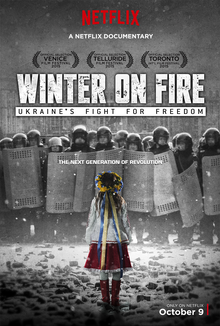Even if it weren’t important enough before, this documentary became practically required watching after the full-blown Russian invasion of Ukraine beginning last year. I kept putting it off because I felt that I’d already read up enough on the events. Finally watching it really helped establish in my mind just how long the entire Euromaidan protests lasted and how difficult it must have been to sustain that level of commitment in the face of every obstacle the government put in their way. At the same time, this documentary feels insufficient and incomplete. It strictly restricts itself to the protests centered around Maidan Nezalezhnosti and to the perspective of the protesters. There’s nothing at all about what was happening elsewhere in Ukraine at the time or of about the politicking behind the scenes so when the protesters finally win, it’s an abrupt and almost inexplicable shock.
This film recounts how the protesters first started to gather in the central square in Kyiv in November 2013 when then President Viktor Yanukovych decided not to sign an association agreement with the EU and opted for closer ties with Russia instead. Protesters who saw Ukraine as being part of Europe refused to accept this future started to gather. The numbers were initially small and the gatherings sporadic. By the end of the month the government attempted to use the Berkut special police units to remove the protesters by force, employing batons, stun grenades and tear gas. This use of force led to widespread outrage and increased the number of people participating in the protests. The people started erecting barricades, tents, and other infrastructure to entrench their positions. Meanwhile there were groups of car owners organizing logistics for the protesters, medical aid and later even training their own defense units. All this would culminate in February 2014 when live ammunition were used against the protesters, leading to many deaths. The film ends quite suddenly with Yanukovych fleeing and the subsequent establishment of a new interim government.
Director Evgeny Afineevsky makes use of both historical footage and extensive after-the-fact interviews with a wide selection of those involved to forge a coherent narrative that is firmly sides with the protesters. One particularly fascinating interlocutor for example is a 12-year-old who enthusiastically participates throughout the entire months-long revolution, either helping at the tech tent or standing on the frontlines to lob stones at the police. There is plenty of graphic footage of the violence as the Berkut units gang up on and beat up protesters and disturbing shots of injuries and bloodied faces. The emphasis is on the heroism and solidarity of the protesters, showing how even Ukrainians of different religions stand united against the Yanukovych government. Smart looking animated maps help foreigners especially keep track of how the action moves between the square and key streets of Kyiv. It works well enough as a basic primer to let viewers understand what the Maidan Uprising was about and what happened.
This kind of unwavering focus on only the square itself gives the viewer a visceral sense of what really went down on an almost day-to-day basis. However the narrow perspective makes it repetitive after a while and it leaves out so much of the wider context. So this film tells you how Ukrainians from other cities are travelling or sending supplies to Kyiv but doesn’t mention that at times, protests at Lviv were larger. Naturally it doesn’t cover the pro-Russian protests in Kyiv and elsewhere in Ukraine as well. In general it does a rather poor job at identifying how and who the political leaders involved are, not explaining the Kyiv city government supports the protesters or how the political settlement that led to the end of the protests was achieved. More controversially, it tries hard to convince viewers of how united the Ukrainians were and skips over some of the most virulent protesters were neo-Nazis. The truth as always is complex and multi-faceted and this documentary consciously chose to portray only a fraction of the whole picture.
I’d still recommend this documentary highly because the uncensored images of police brutality are incredibly powerful and it’s really quite something to see a mass protest movement like this succeed in overthrowing a state in the modern era. It is important however to independently read up on the full story of the protests as there is so much more than is shown here.
